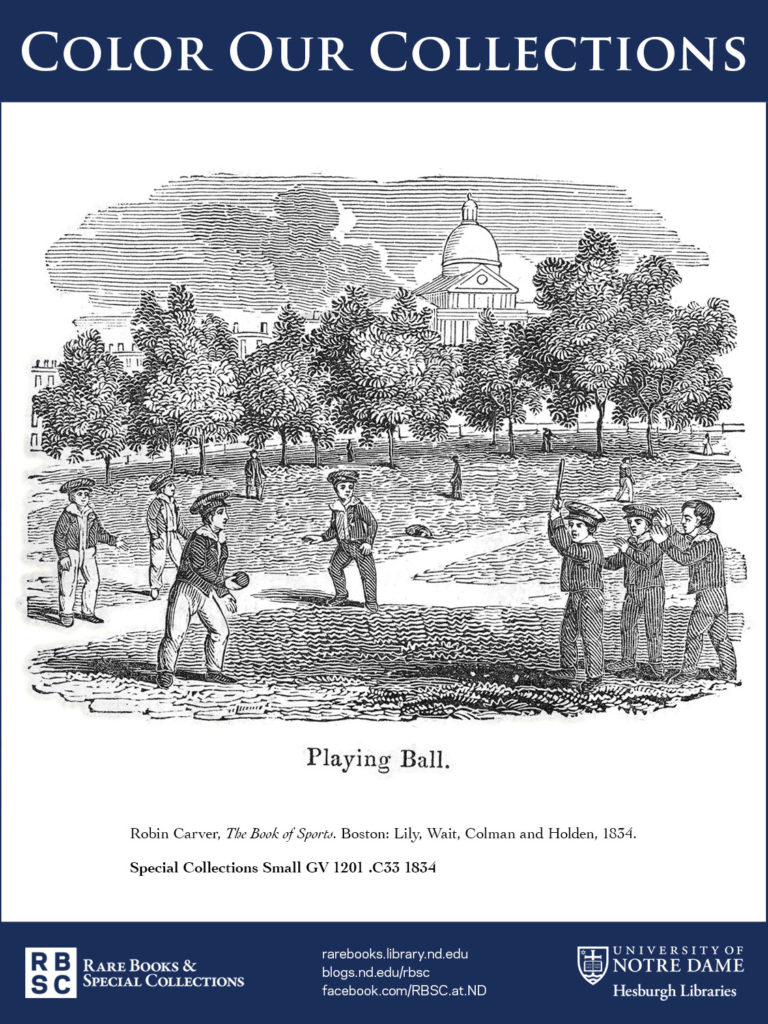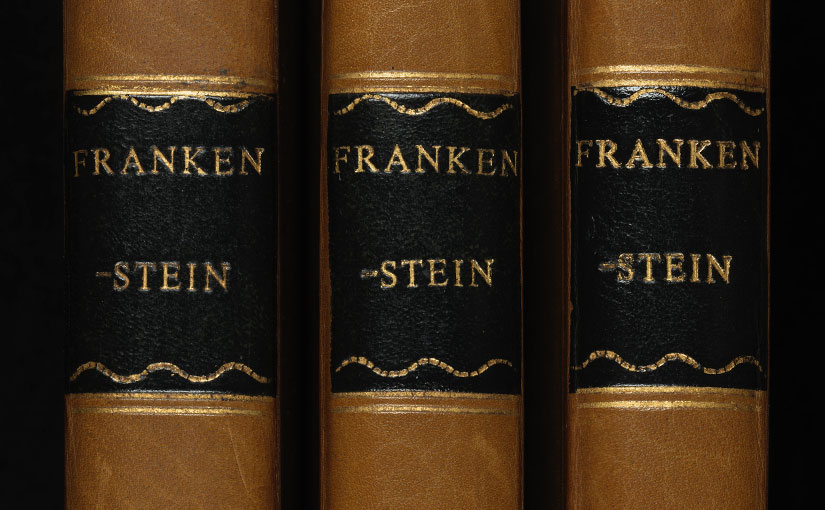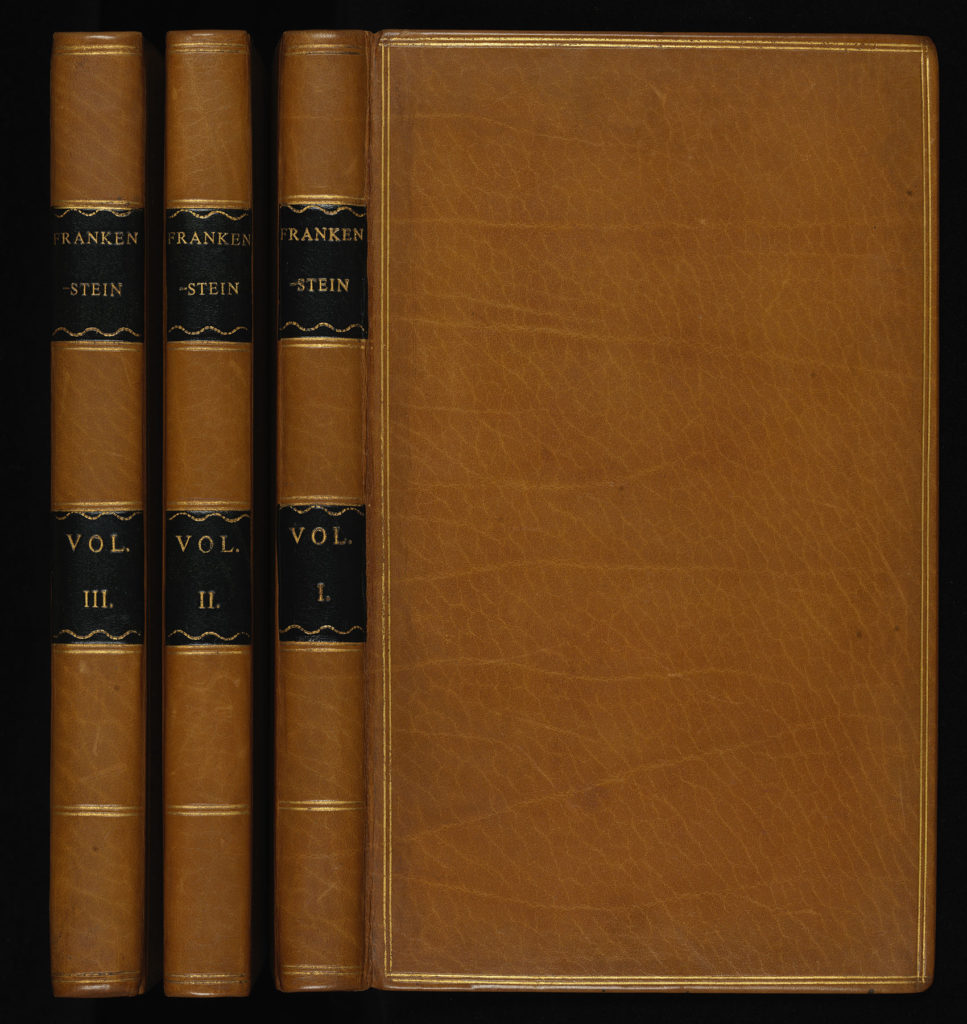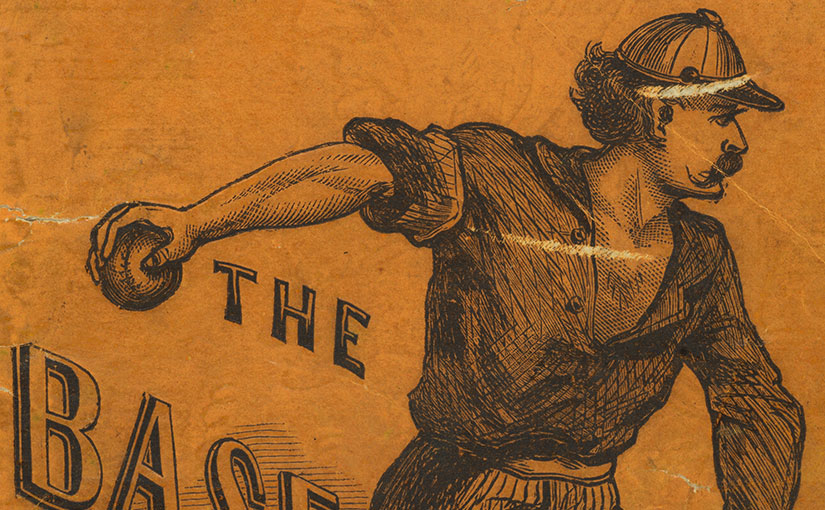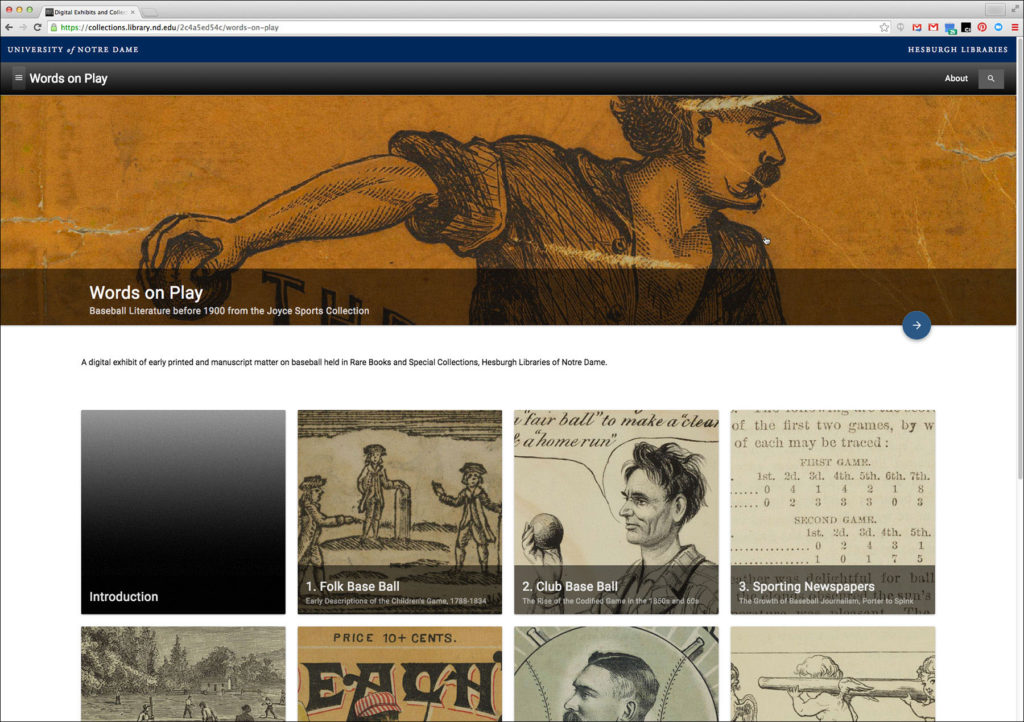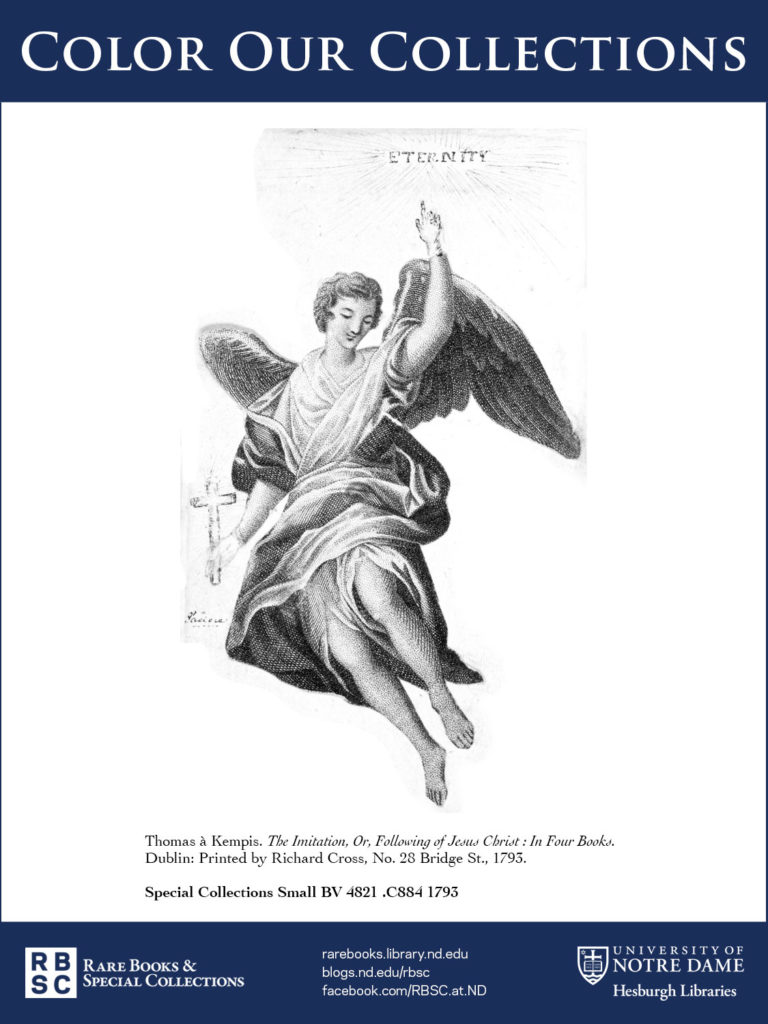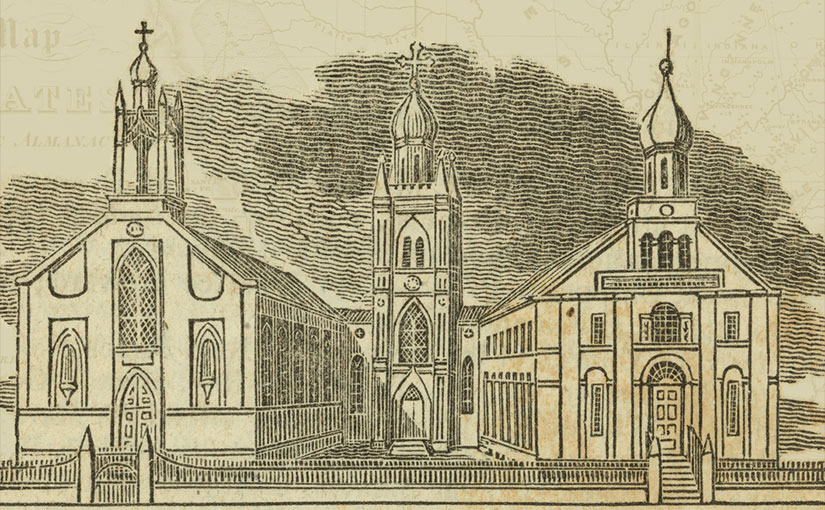Today’s coloring sheet comes from our most recent digital exhibit, “Words on Play: Baseball Literature before 1900 from the Joyce Sports Collection”. This online exhibition displays early printed and manuscript matter on baseball held in Rare Books and Special Collections, Hesburgh Libraries of Notre Dame, and is curated by George Rugg.
Category: Exhibits
Recent Acquisition: First Edition Frankenstein (1818)
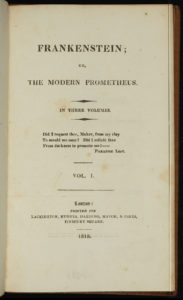 A fine, first edition of one of the most influential works of European literature and the most taught novel in universities—Mary Shelley’s Frankenstein—enhances our European literature collection. The stunning volumes now complement our holdings of the first illustrated edition (third overall edition) published in 1831 by Colburn and Bentley and the first American movie tie-in edition printed by Grosset and Dunlap in 1931.
A fine, first edition of one of the most influential works of European literature and the most taught novel in universities—Mary Shelley’s Frankenstein—enhances our European literature collection. The stunning volumes now complement our holdings of the first illustrated edition (third overall edition) published in 1831 by Colburn and Bentley and the first American movie tie-in edition printed by Grosset and Dunlap in 1931.
Shelley’s novel was first printed anonymously in three volumes in 1818 for the London publishing firm Lackington, Hughes, Harding, Mayor, and Jones in an edition of 500 copies. RBSC’c set is tastefully bound in contemporary style in 20th-century tan, smooth morocco. Spines are gilt-ruled in compartments with black morocco title labels and the sides are bordered with a double gilt rule.
The acquisition of the first edition of Frankenstein was made possible by the Hesburgh Libraries, a Nanovic Institute for European Studies Library Grant, the Department of Political Science (Notre Dame), and Professor Eileen Hunt Botting in memory of her brother, Kevin E. Hunt.
Mark Your Calendars – Upcoming Events
Mary Shelley’s 1818 Frankenstein will be the centerpiece of a spotlight exhibit, It’s Alive! Frankenstein in the Arts and Sciences, in Special Collections in Fall 2018. The exhibit will be part of a series of campus-wide events celebrating the bicentennial of Frankenstein.
Special Collections will also host a multidisciplinary panel discussion on Friday, October 19, 2018 with faculty from both Indiana University School of Medicine at South Bend and the University of Notre Dame exploring Frankenstein’s relevance to 21st-century medicine and medical ethics.
Upcoming Events: May and through the summer
Please join us for the following events being hosted this summer in Rare Books and Special Collections:
Thursday, June 1 at 2:00pm | Exhibit Talk — “21st Century Digital Approaches to Rethinking 19th Century Catholic Print” – Kyle Roberts (Loyola University Chicago).
Monday through Friday, June 12-16 at 9:00am to noon | RBSC Nuts & Bolts — ARCHIVES! Intensive Workshop for Conducting Archival Research – Rachel Bohlmann, Ph.D. (Notre Dame, American History Librarian) and Julie Tanaka, Ph.D. (Notre Dame, Curator in Special Collections).
The current exhibit, “Preserving the Steadfastness of Your Faith”: Catholics in the Early American Republic, will run through the summer and close on August 11, 2017.
The current spotlight exhibit, “Exhibition of Artifacts from Mother Cabrini’s Archive”, will close May 19. The summer spotlight exhibit will highlight North American Antebellum friendship albums and will open the following week.
Rare Books and Special Collections is open
regular hours during the summer —
9:00am to 5:00pm, Monday through Friday.
RBSC will be closed for Memorial Day, May 29th,
and the Fourth of July.
“Words on Play: Baseball Literature before 1900” digital exhibit
Among the harbingers of spring here in RBSC is the introduction of a newly completed digital exhibit of early baseball publications and manuscripts drawn from the holdings of the Joyce Sports Collection. “Words on Play: Baseball Literature before 1900” brings together recreational manuals, guidebooks, histories, biographies, fiction and other forms, including many of the subject area’s great rarities. The exhibit was created by RBSC’s Americana curator, George Rugg.
Over the course of the nineteenth century, American baseball evolved from a localized folk game of English origin to a codified sport of broad popular appeal, commonly cited as the “National Pastime.” Clubs of young men dedicated to playing the game began to appear in earnest in the New York City area in the second quarter of the century; the rules they established became the basis for the sport as we know it today. In the post-Civil War years baseball became thoroughly commodified: crowds of paying spectators gathered in enclosed “parks” to watch celebrated professionals compete at an elite level. By 1900 baseball had entered the mainstream of American popular culture, and had been imbued with many of the mythologies that would persist in the minds of its celebrants well into the twentieth century: baseball as pastoral ideal, baseball as an exercise in democracy, baseball as secular religion. As a recreational form, then, baseball originated in England, but as a form of sport it is American, for it was in America that the game became standardized, organized and popular—and, one might add, the subject of a literature.
The printed word both recorded baseball’s growth and stimulated it. In the first few decades of the nineteenth century the game is mentioned mainly in children’s recreational manuals. Baseball’s rapid rise after mid-century was accompanied by a growing commentary, mainly in sporting newspapers and paper-bound annual guides, describing, discussing, and otherwise publicizing the game. By the 1880s and 90s coverage of professional baseball in urban daily newspapers had became routine, and many of the familiar genres of baseball book had made their appearance. Baseball journalists—who authored many of the books in this exhibit—never tired of emphasizing their contribution to the game’s success, and that contribution was no doubt great. Still, the number of baseball monographs published in the nineteenth century was not large; “Words on Play” brings together copies of most of the key publications of baseball’s early history.
Questions and comments may be directed to George Rugg, Americana curator.
 This work is licensed under a Creative Commons Attribution 4.0 International License.
This work is licensed under a Creative Commons Attribution 4.0 International License.
Upcoming Events: April and early May
Please join us for the following events being hosted in Rare Books and Special Collections (102 Hesburgh Library):
Thursday, April 13 at 5:00pm | The Italian Research Seminar — “Visualizing Fascism” by Ruth Ben-Ghiat (New York University). Sponsored by Italian Studies at Notre Dame.
Thursday, April 27 at 5:00pm | The Italian Research Seminar — “Living on borders: Cityscapes in transformation in Italian literature and cinema of the ‘Economic Miracle’ ” by Alberto LoPinto (Notre Dame). Sponsored by Italian Studies at Notre Dame.
The current exhibits are:
“Preserving the Steadfastness of your Faith”: Catholics in the Early American Republic.
To schedule a class or group tour, please contact Rachel Bohlmann via email or phone: (574) 631-1575.
Spotlight Exhibit: Exhibition of Artifacts from Mother Cabrini’s Archive
Color Our Collections: Catholics in the Early American Republic exhibit
Today’s coloring sheet comes from our current exhibit, “Preserving the Steadfastness of Your Faith”: Catholics in the Early American Republic. This exhibition displays examples of American Catholicism expressed through (mostly) printed texts from 1783 through the early 1840s and is curated by Rachel Bohlmann (U.S. History & American Studies)and Jean McManus (Catholic Studies).
The exhibit is open to the public through August 11, 2017.
Upcoming Events: March and early April
Please join us for the following events being hosted in Rare Books and Special Collections (102 Hesburgh Library):
Wednesday, March 22 at 4:00pm | Exhibit Talk — “Saint Elizabeth Seton: A Reading Life” by Catherine O’Donnell. Co-sponsored by the Hesburgh Libraries and the Cushwa Center for the Study of American Catholicism.
NOTE: THIS EVENT HAS BEEN RESCHEDULED
Thursday, March 30 April 27 at 5:00pm | The Italian Research Seminar — “Living on borders: Cityscapes in transformation in Italian literature and cinema of the ‘Economic Miracle’ ” by Alberto LoPinto (Notre Dame). Sponsored by Italian Studies at Notre Dame.
The current exhibits are:
“Preserving the Steadfastness of your Faith”: Catholics in the Early American Republic.
Join co-curators Rachel Bohlmann (American History Librarian) and Jean McManus (Catholic Studies Librarian) for a guided tour Thursdays at 12:30 pm through March (excluding Spring Break, March 16), and learn more about American Catholic history held in the library’s Rare Books and Special Collections and ND Archives. Tours will last up to an hour.
To schedule a class or group tour, please contact Rachel Bohlmann via email or phone: (574) 631-1575.
Spotlight Exhibits: Bram Stoker’s Lecture on Abraham Lincoln and The Nathaniel Rogers Sermon Notebook, ca. 1634-1645.
Who’s Who in RBSC: Rachel Bohlmann and Jean McManus
The two fencers in Domenico Angelo’s L’Ecole des armes saluted, closing Ingenious Exercises, and welcomed Matthew Carey and the transatlantic story narrated in “Preserving the Steadfastness of Your Faith”: Catholics in the Early American Republic. The new Spring exhibit features printed books, newspapers, and pamphlets that document the flow of ideas about Catholicism between the United States and Europe.
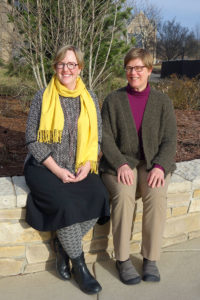 Bringing coherence to the flurry of ideas represented by the diverse artifacts on display are Rachel Bohlmann and Jean McManus. Rachel and Jean (U.S. History & American Studies librarian and Catholic Studies librarian, respectively) teamed up to explore what our collections held on Catholic America. As they began this seemingly daunting task, they soon realized they first needed to address what exactly Catholic literature in America was and what it meant to be a Catholic in America.
Bringing coherence to the flurry of ideas represented by the diverse artifacts on display are Rachel Bohlmann and Jean McManus. Rachel and Jean (U.S. History & American Studies librarian and Catholic Studies librarian, respectively) teamed up to explore what our collections held on Catholic America. As they began this seemingly daunting task, they soon realized they first needed to address what exactly Catholic literature in America was and what it meant to be a Catholic in America.
For Jean, these questions stemmed from Notre Dame’s 2014 acquisition of the The Holy Bible printed in 1790 in Philadelphia by Matthew Carey, more commonly referred to here [on campus? at Notre Dame?] as the Badin Bible. This bible is a copy of the first authorized Catholic bible in English and was translated from the Latin Vulgate in 1568 by members of the English College, a Catholic seminary in Douai in northern France. Its publisher, Matthew Carey, was an Irish Catholic who emigrated to Philadelphia. Known for standing against the British Parliament in defense of Irish nationalism and Catholic emancipation, Carey became a successful Catholic publisher in the U.S. Jean questioned what it meant to be a publisher who was Catholic and, more broadly, what it meant to be Catholic in America.
For Rachel, a common theme that emerged among these sources was their transatlantic identity. As she and Jean chose particular stories to tell, each story connected to Britain or Europe, often in multiple ways. These ties could be in the form of refugees as in the case of Stephen Badin who fled Revolutionary France or ideas such as the pamphlets that circulated between the US, Europe, and Britain and, sometimes, the ties involved both refugees and ideas.
Turning to the principal Catholic Studies reference book, Wilfrid Parson’s Early Catholic Americana, they compared Special Collections’ holdings to the works listed in Parson and selected most of the items on exhibit based upon their inclusion in this work. Their selections represent American Catholicism defined by early printed works that include books, pamphlets, newspapers, official reports, and maps. What emerges is a six-chapter, multinational story beginning in the 1780s and running through the 1840s of early Catholicism in America and its ties to European Catholicism.
The exhibit runs January 16 – August 11, 2017. Weekly tours led by Rachel and Jean on Thursdays begin at 12:30 and will be offered through the end of March. Class tour are also available. Please contact Rachel to schedule a tour.
Upcoming Exhibit Events
“Saint Elizabeth Seton: A Reading Life”
Catherine O’Donnell, Professor of History, Arizona State University
March 22, 2017, 4:00 pm, Special Collections
Historian and former Cushwa Center Fellow Catherine O’Donnell’s talk explores Elizabeth Ann Seton’s spiritual journey as it intersected with Catholic history during the early American Republic. O’Donnell is the author of “John Carroll and the Origins of an American Catholic Church, 1783-1815” and Men of Letters in the Early Republic: Cultivating Forums of Citizenship (2008). She is currently completing her second book, Elizabeth Seton: a Life.
“21st Century Digital Approaches to Rethinking 19th Century Catholic Print”
Kyle Roberts, Professor of Public History & New Media and Director of the Center for Textual Studies & Digital Humanities, Loyola University Chicago
June 1, 2017, 2:00 pm, Special Collections
This talk explores the ways in which new digital humanities projects, such as the Jesuit Libraries Provenance Project, have allowed us to recover the central importance of print to American Catholics. Roberts is also the author of Evangelical Gotham: Religion and the Making of New York City, 1783-1860 (2016).
Upcoming Events: February and early March
Please join us for the following event being hosted in Rare Books and Special Collections:
Thursday, Feb. 23 at 5:00pm | The Italian Research Seminar: Graduate Student Presentations — “Memory, narration and intertextual references: Shakespeare’s presence in the works of Primo Levi” by Valentina Geri, and ” ‘I don’t like labels’: Reactions to the Publication of The Complete Works of Primo Levi” by Lorenzo Bonaiti. Sponsored by Italian Studies at Notre Dame.
Tuesday, Feb. 28 at 4:30pm | The book launch for A Descriptive Catalogue of the Medieval and Renaissance Manuscripts of the University of Notre Dame and Saint Mary’s College by Dr. David T. Gura. Sponsored by the Hesburgh Libraries, Medieval Institute, and University of Notre Dame Press.
The exhibits during February are:
“Preserving the Steadfastness of your Faith”: Catholics in the Early American Republic.
Birds! Winged Wonders in Naturalists’ Eyes concludes this week and a new exhibit goes in showcasing a 13th-c. Bible leaf from a Parisian Bible painted by the Dominican Painter, once in the possession of Chester Beatty: A Leaf from the Chester Beatty Bible (W.116).
Exhibit Opens – “Preserving the Steadfastness of Your Faith”: Catholics in the Early American Republic
“Under these distressful feelings, one consideration alone relieved me . . . and that was, the hope of vindicating your religion to your own selves at least, and preserving the steadfastness of your faith.” — John Carroll, An Address to the Roman Catholics of the United States of America
With these words, John Carroll, head of the fledgling Catholic Church in the United States and future bishop, encouraged his fellow Catholics in 1784. Catholics held a precarious position in the Early Republic despite having gained more freedom to practice their religion after the Revolution. By the 1840s, in the face of increasing sectarian-driven violence, Catholicism had taken firm institutional root.
This exhibition displays examples of American Catholicism expressed through (mostly) printed texts from 1783 through the early 1840s. They include the earliest Catholic bibles published by Mathew Carey, and editions of Thomas à Kempis’ The Imitation of Christ used and produced in the United States; polemical pamphlets with sexual and political subtexts that flew back and forth across the Atlantic; no-holds-barred dueling sectarian newspapers; books and pamphlets created in reaction to mob violence against the Ursuline convent school near Boston; and official reports that mapped the Church’s growth and growing pains.
This exhibition is curated by Rachel Bohlmann and Jean McManus and is open to the public through August 11, 2017.

